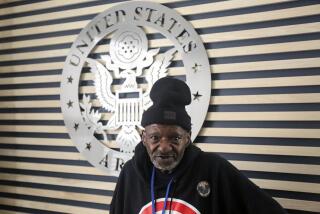Intrepid Airmen Become Veterans, 47 Years After WWII : Aviation: Consairway employees, who ferried B-24s and PBYs overseas, realize long-sought goal in receiving the status.
- Share via
Veteran status confers more than government guaranteed home loans and GI Bill of Rights college benefits. It involves a lot of patriotic pride as well.
Just ask El Cajon resident Phil Thompson, who finally received his official veteran designation 47 years after he flew his last mission as a civilian navigator for Consairway, the World War II-era airline whose B-24s bombers were built at Lindbergh Field.
Thompson, 79, is one of 280 surviving Consairway pilots, navigators and ground crew members who this year successfully petitioned the Air Force for official recognition as veterans. About 90 of the survivors live in San Diego County.
For retiree Thompson, living comfortably on a city of San Diego pension for years of service as a city engineer, the financial benefits were far from his mind when he learned in August that he and other Consairway people were, finally and officially, veterans.
“It means we get official recognition for having taken part in World War II and in the defeat of the Japanese,” Thompson said. “It also wipes away the stigma that we were in it for mercenary reasons.”
Consairway was the wartime civilian airline established by Consolidated Vultee, the predecessor company to General Dynamics Convair that built 18,000 B-24 bombers and PBY amphibious patrol planes at Lindbergh Field facilities during World War II.
The wartime manufacturer delivered the aircraft to the Army Air Corps at military installations in the South Pacific theater of operations halfway around the world from San Diego. Until the war started on Dec. 7, 1941, the crews that flew the planes to bases such as Clark Air Field in the Philippines would take ship passage back to the United States.
But the war changed all that, particularly after the Japanese captured and imprisoned a crew who had delivered a plane to Manilla. So, Consolidated Vultee began the airline in 1942 principally to provide safe passage for their air crews.
But the airline quickly took on much more importance as the war effort gathered steam. To deliver the planes and pick up the personnel, Consairway crews virtually discovered and mapped South Pacific air routes, expertise that was valued highly by the Air Transport Command. In a real sense, Consairway pilots and navigators such as Thompson were charting new territory. So the military assigned the airline hundreds of military missions.
Based at Hamilton Air Force Base in the San Francisco Bay area, Consairway began operations on April 23, 1942, under contract to the Army Air Corps. At its peak, the airline consisted of 80 flight crews flying 18 B-24 Liberator bombers converted for cargo use. The airline delivered munitions and personnel in hundreds of missions between 1942 and 1945, including flights into Guadalcanal and Tarawa during combat.
The airline also flew USO entertainers such as Bob Hope and Joe E. Brown as well as Eleanor Roosevelt and Gen. Douglas MacArthur’s staff. The airline had maintenance bases at Hickham Field in Hawaii, Guam, Guadalcanal, Australia and New Guinea.
Art Wrightson, a San Diego resident who is president of Consairway Reunion Group, said the flights were often hazardous.
“We didn’t fly with camouflage because taking the paint off made the planes lighter,” Wrightson said. “And we had no armaments, not even side arms. One of our crew was taken prisoner by the Japanese and one navigator was killed in a strafing.”
“Some people said we had the Right Stuff of the ‘40s comparing us to the astronauts because we were pioneers in flying land-based aircraft across that great expanse of water,” Wrightson said.
Even though Consairway personnel wore military uniforms and flew hazardous missions, the post-war Air Force regarded the men and women who flew the missions and maintained the airplanes as civilians.
That always nettled the Consairway folks, particularly after pilots and crews flying military missions on other commercial airlines such as Pan Am and United were given veteran status.
Then in July, 1991, Consairway veteran Lou Krause of Redondo Beach read about the Flying Tigers achieving veteran status. The Flying Tigers were group of civilian U.S. fighter pilots who fought on behalf of China against the invading Japanese early in World War II.
Krause called Torrance tax attorney Robert Schriebman, an aviation buff whose interest in aviation led him to take up the cause of the Flying Tigers. Schriebman had successfully presented the Tigers’ case before the Pentagon. Upon hearing Krause’s description of the Consairway operations, Schriebman knew Consairway could also qualify for veteran status.
“New regulations mean that as long as you could make a good presentation and prove that you were in combat operations, you would qualify,” Schriebman said.
Schriebman submitted a thick brief for Consairway to the Department of the Air Force in October, 1991. Sure enough, in April of this year, just in time for Consairway veterans’ 50th annual reunion at the Hanalei Hotel in Mission Valley, the Air Force notified the group that the status was forthcoming. By August, veteran status for Consairway personnel was official.
Apart from the fact that more than a quarter of the airline’s surviving personnel live in San Diego County, Consairway has special significance for San Diego in other ways. It’s another way that Consolidated Vultee, the predecessor company of Convair, made its imprint on San Diego.
A touch of irony is that not one B-24 remains in San Diego of the thousands made at the Lindbergh Field. In fact, only two are in flying condition anywhere in the world, Thompson said.
More to Read
Sign up for Essential California
The most important California stories and recommendations in your inbox every morning.
You may occasionally receive promotional content from the Los Angeles Times.













